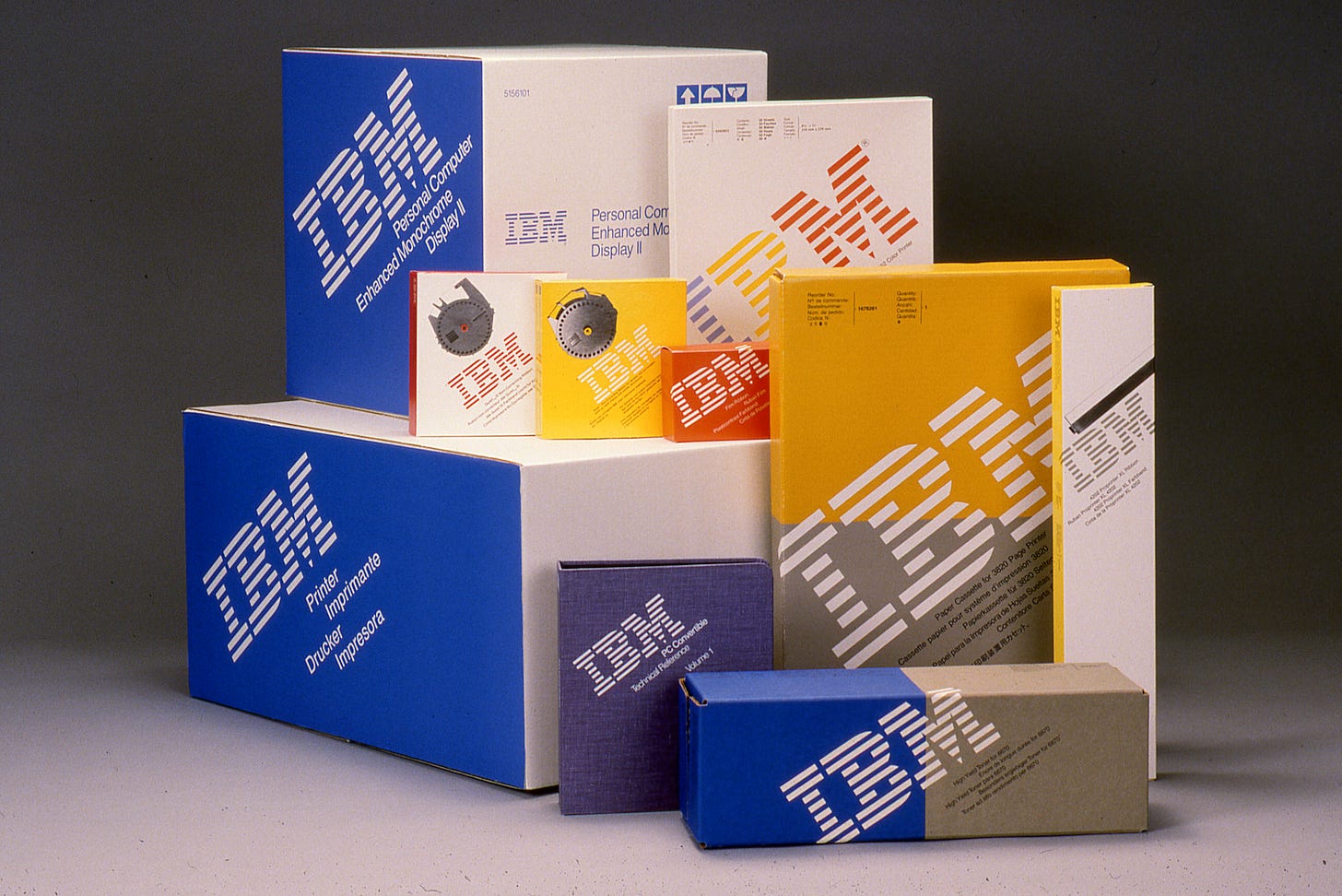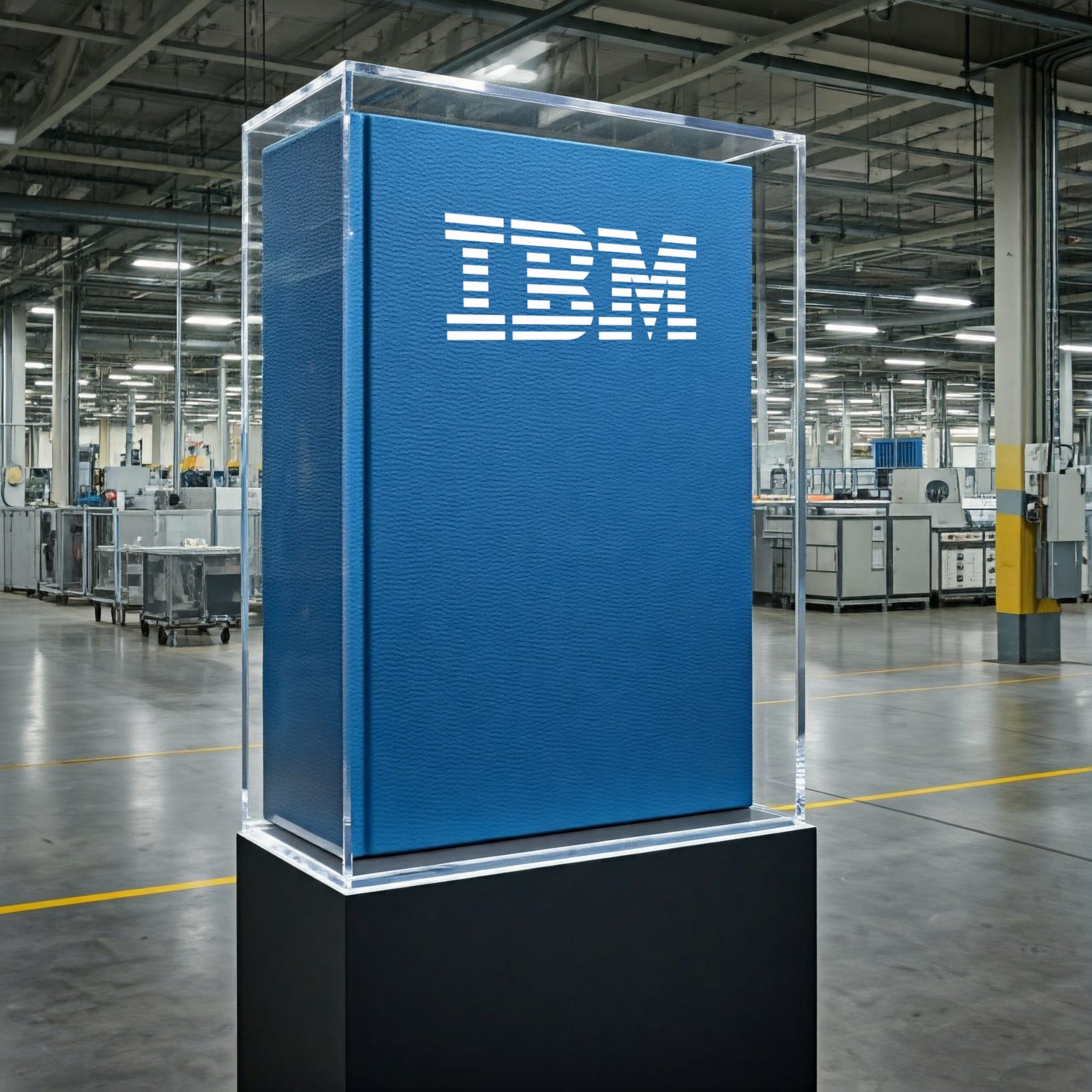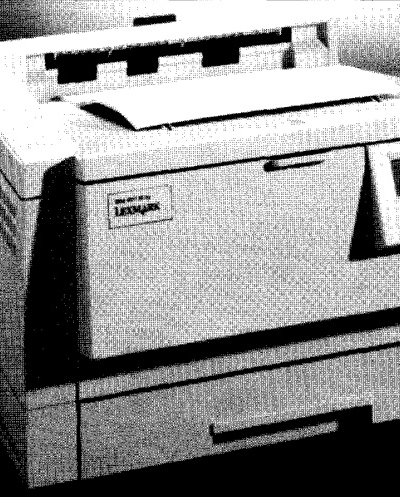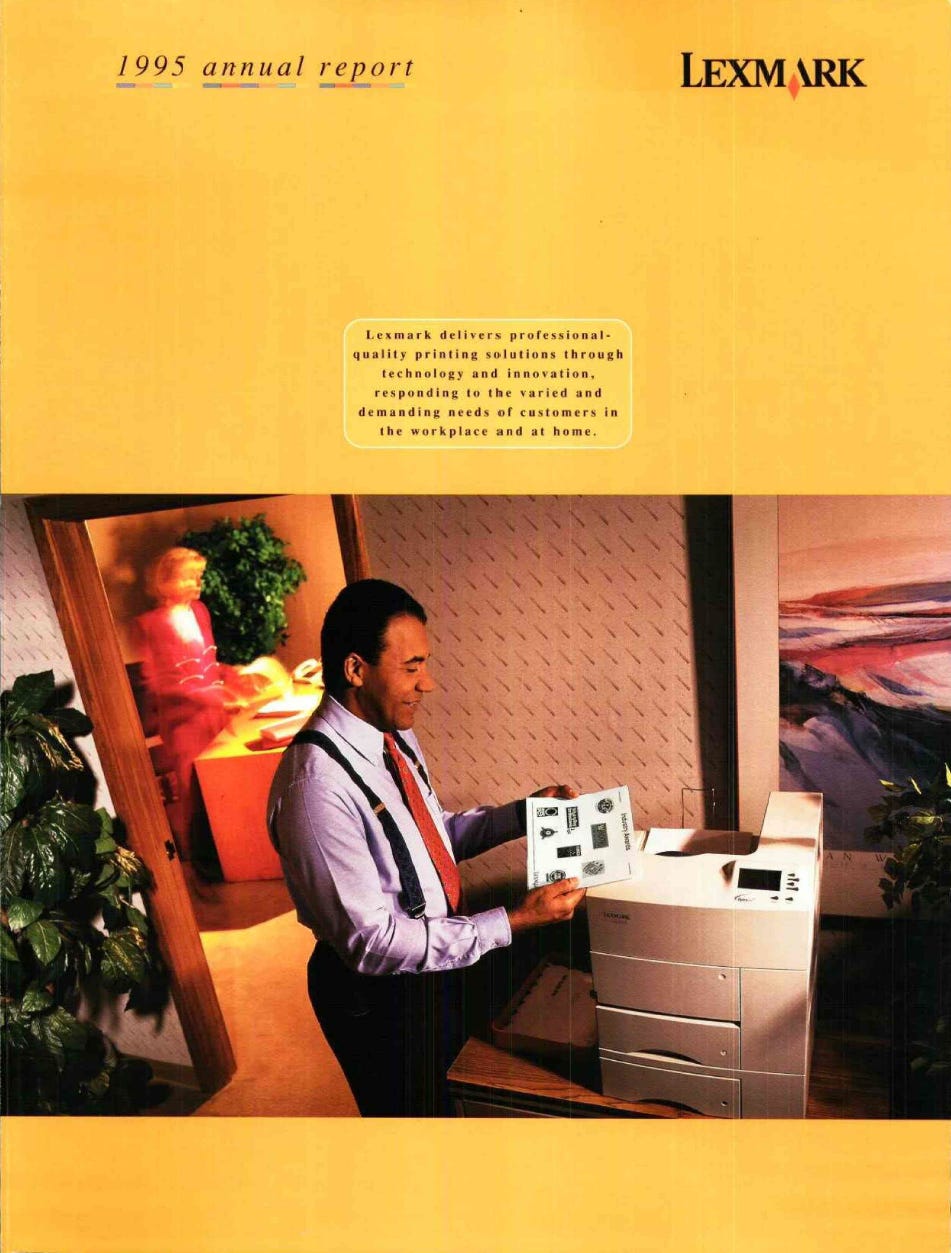Excising the Old
Clayton Dubilier's LBO of Lexmark, IBM's Printer Division
This is Part Three of a three-part series on IBM’s electric typewriter division. Here are links to Part 1 (“Like Tears in Rain”) and Part 2 (“Asphyxiation by Abundance”).
Tough Times, Cash Drains
In the 1980s, IBM allowed cultural and organizational problems to build. Faster moving competitors were taking share in old product lines and leaving IBM behind in new markets. Thus, From 1986 to the end of 1992, IBM Chairman John Akers shrunk headcount from 407,000 to 327,000. Cash was going out the door to fund these “early retirements” just at the time revenues and profits were under strain. In the quest to raise cash and to jettison under-performing business units, Akers saw IBM’s printer and typewriter division, based in Lexington, KY, as a good target. IBM had entirely missed the boat for consumer-priced laser printers. Growth and margins at the printer division were both below what IBM wanted.
Sales Process: Nonconcurrences Up the Wazoo
Akers in 1990 decided he wanted to sell the printer division to Clayton Dubilier (“CD”), then a small leveraged-buyout firm with a reputation for responsibly turning around companies as opposed to looting and pillaging them. It was Dan Gogel, a partner at C&D, that was the lead for the IBM printer division deal.
The deal valued IBM’s division at $1.85 billion. IBM would sell 90% to CD and keep 10% for itself. Key to making the deal work was CD securing a variety of patent rights from IBM. These patents were essential to the development of future products. This is when Gogel first experienced the excruciatingly slow and frustrating IBM management culture.
Gogel thought he had secured the rights to the patents from a senior Akers lieutenant. However, Gogel then had to butt heads with a junior IBM lawyer over the patents. The junior lawyer said it was the policy that those rights can’t be given out. Even though the boss at the printer division said one thing to Gogel, this lawyer didn’t report to the boss of the printer division. If Gogel wanted to get the rights, he’d have to escalate and launch a formal protest. Gogel launched the protest. It took several weeks before IBM’s Management Committee formally agreed to give CD the patent rights.
IBM managers and lawyers continuously bogged down the entire process for closing the deal with CD. Chairman Akers had to personally shepherd this deal through. Paul Carroll in his book Big Blues describes in detail IBM’s stultifying corporate environment:
All sorts of issues eventually made it to the Management Committee, or at least to a level below the MC, because some staff operation at IBM that seemingly had no control over the business in Lexington disagreed—or nonconcurred—with something the business’s managers had decided to do. IBM’s procurement people found out that some senior person responsible for the Lexington operations had agreed to buy only Lexmark laser printers for IBM’s internal use. The procurement group nonconcurred.… IBM’s accounts payable group found that an IBM negotiator had agreed to give Lexmark favorable treatment by paying bills in thirty days instead of the normal sixty. The accounts payable people nonconcurred. Akers found himself having to get involved in that detail too.
A non-concurring IBM manager in the Netherlands nearly derailed the signing of the $1.2 billion loan to CD. The reason? This particular IBMer discovered at the last second the deal was going to force him to eat some inventory, so he nonconcurred and the loan couldn’t be completed. A senior IBM had to call the Netherlands to tell this other manager that while he had every right to go through the formal IBM process, this time it was just too bad.
By the time the IBM and CD finally signed off on the deal, Gogel had become so fed up with the formal escalation process at IBM that he made up a fake board game he named “Nonconcur”. He passed it out to 350 of the people involved in the negotiations, even to Akers.
Out with IBM, In with Lexmark
With the deal finally completed in March 1991, CD quickly went to work turning around IBM’s printer division. First they gave it the name Lexmark International. Next, CD installed former IBM VP Marvin Mann as CEO.
Then Mann went to work. One of the first things he did was to dismantle the IBM culture that had strangled everything like kudzu. One action was highly symbolic: he encased an old IBM development manual in Lucite and had it displayed on the plant floor. He didn’t want anyone to forget the old ways that had held back their potential. He also wanted everyone to know the manual could never be opened again.
As reported by The Economist in 1992, Mann also made another symbolic change. He abolished the company’s suggestion box:
“As a symbolic gesture, Mr. Mann abolished the suggestion box. He reckoned that rewarding employees for suggestions gave the wrong impression. Instead of suggesting to other people how to do things better, Mr. Mann wanted his people to go ahead and make things better themselves.”
No more suggestions. More action. Less talking and more doing.
Mann also implemented simple, practical changes. Most importantly, he got rid of the contention system. Carroll in The Wall Street Journal reported on Lexmark ending IBM’s “hallowed” contention system on July 23, 1992:
“But Lexmark’s biggest change was to drop IBM’s hallowed “contention” system. Under it, staffers with different goals battle for months, reassuring IBM because the resulting decision usually is sound. But, especially lately, the fights have put IBM months behind rivals in markets where a product may last only a year.
Lexmark ended “contention” by wiping out just about all the corporate staffs that used to do battle. Led by Marvin Mann, a former IBM vice president who became Lexmark's chief executive, and with guidance from its new owner, Clayton, Dubilier & Rice, the executive team also tried to keep midlevel managers out of mischief by giving them so much to do that they had to ease up on the controls.”
Mann also cut meetings and business travel to a minimum. He banned the use of foils (presentation slides) to communicate at meetings. Mann gutted corporate staff to the point it was just twenty people at Lexmark headquarters running a $2 billion revenue business.
And here’s yet another crazy example of the bloat and beaurocracy at old IBM. After being acquired by Clayton Dubilier (emphasis mine):
“Lexmark also went through file cabinets, throwing out drawers and drawers of forms that it didn’t need, and it reevaluated what had to be on those remaining. Mr. Survant says the information required to justify an engineering change was cut to 24 items from 58. And when the engineers investigated who had needed all that information anyway, ‘you couldn’t even find anyone who knew,’ he says. ‘That's the crazy thing. Nobody even remembered.’”
In essence, Mann’s changes resulted in greater decentralization and a flattening of the organization.
An assembly-line worker at the new Lexmark was now just four levels below the CEO. At old IBM it would have eight levels of separation.
Information and data was shared with more people. An assembly line manager now for the first time had interest costs associated with inventory he stockpiled.
Employees realized that without beaurocracy (i.e., fewer people, or nobody, to blame), they now had to take personal responsibility for their work or else they’d be out of a job.
Case Study: Lexmark ValueWriter 300
The changes at Lexmark were so substantial, and successful, that The Association for Manufacturing Excellence (AME) featured it in a case study in its March/April 1995 newsletter Target. Greg Survant, Lexmark’s director of worldwide network printer manufacturing, was the author of the case study.
Here are some of the details on the new low-priced laser printer Lexmark was tasked to design after the LBO (emphasis mine):
“The Lexmark 4037 5E page printer was introduced at a list price of $799, a new price point for Lexmark and its predecessor, IBM. It was delivered in record time—just 23 months—or two thirds the traditional schedule. It took 50 people—or one third of the people normally employed in a project like this. And those people developed a product that exceeded the quality standards we set for ourselves, realized a 4-1 productivity gain and wound up winning a design award from the Society of the Plastics Industry.”
So how did Lexmark succeed in delivering a product in record time with less resources? First, they had to change the culture (emphasis mine).
“We had the heritage of the design of the IBM ProPrinter and the 4029 LaserPrinter to help us with the latest design and manufacture of the highest quality product at the lowest possible price point. But that wasn’t going to be enough. We had to go to the next level. Although we are proud of our IBM heritage, we knew we would have to change the way things had been done in the past. Our new processes of product delivery were bound to run up against the old processes that we inherited from IBM.”
A very diplomatic way of putting it.
Survant wrote further about the old IBM way of doing things. Chucking the old ways was the only way forward:
“The way you go about things becomes habitual, unseen. It is a matter of culture. And to succeed at what we were trying to do, several of us knew we would have to achieve cultural change. To succeed, we had to change the hierarchical, command-and-control structure that had served our former company so well for so long. Naturally, the resistance to such a change can be quite formidable. Not intentionally, but because it is so basic to the way we do business.”
Doing More With Less
Unsaddled with the old IBM ways and resources, Lexmark found it indeed could do more with less. Way more! The number of development projects doubled. Development time was halved even though they had fewer people. Lexmark management let the typewriter assembly workers design their own product line, which cut assembly time from eight hours to a little more than an hour.
Another interesting example of what can happen when management bestows power and responsibility is the story of line workers who saw a contractor installing a ramp in the factory. The line workers asked the contractor how much he was being paid and the guy said $25,000. The line workers stormed into their manager’s office to say this was a job that could have been done at half the cost. This is not something that ever would have happened at IBM.
Another benefit of Lexmark’s separation from IBM was they no longer had to give up 10% of revenues for the general corporate R&D budget. Lexmark could now decide how every dollar was allocated. Remember too, IBM sales people wanted only to sell big ticker, high margin products, not the printer division’s small ticker, lower margin products. Lexmark could now put together a dedicated sales force that would target their core customers and the correct sales channels.
Lexmark’s Results
Clayton Dubilier’s acquisition of Lexmark in 1991 valued it at $1.85 billion. The private equity firm used $205 million of equity and $1.2 billion of debt to acquire its 90% while IBM retained 10%.
Lexmark achieved impressive financial results in just its first year. Lexmark’s operating profits had doubled. Thus, Clayton Dubilier was able to pay the debt down to $900 million at the end of the first year and then down to $700 million the year after that.
Then, in 1995, Clayton Dubilier took Lexmark public in an oversubscribed offering—nearly 20 million shares were sold at a price of $20. By the time Clayton had fully exited Lexmark in 1998, it had earned about $1 billion from the investment. This is five times their equity investment in a period of seven years. Operating margins had improved by 12.5 percentage points, from -1.5% at the end of 1991 to 11% at the end of 1997.
And it wasn’t just the private equity investors that did well. Clayton Dubilier set aside 15% of their shares of Lexmark for employees at the time of the leveraged buyout.
As Paul Carroll wrote, “Lexmark became the best example yet of what could happen if some way was found to keep the IBM technology and the skills of its people while blowing up the stultifying culture.” Lexmark’s success post-IBM would become such a thorn in John Akers’ side, that when one IBM executive pointed out to Akers how much it helped Lexmark to have its own sales force, Akers blew up. He yelled, “I’m sick and tired of hearing about Lexmark!”
Takeaways
As I wrote in Part II of this series, large parts of IBM were essentially asphyxiated due to an abundance of resources. Too much money, too many managers and lawyers, too much willingness to give every single person a chance to voice their opinion (i.e., “nonconcur”). Too little of accountability, empowerment, and sense of urgency.
Changing the culture, flattening the organization, and giving more power and responsibility to employees led to efficiencies and cost savings all around for IBM’s former printer division. It led to an acceleration of product development and revenue growth even though Lexmark had far fewer resources than when when they were a part of IBM.
The LBO of Lexmark by Clayton Dubilier is an amazing story of a cultural turnaround and application of the right incentives.
Sources
“I.B.M. to Complete Unit Sale in March”, New York Times, Jan. 12, 1991.
“Can I.B.M. Learn From a Unit It Freed?”, New York Times, Dec. 22, 1991.
“Culture Shock: Story of an IBM Unit That Split Off”, Wall Street Journal, July 23, 1992.
“Lexmark: The Typing on the Wall”, The Economist, October 3, 1992.
“For New I.B.M. Chief, Spinoff May Be a Model”, New York Times, March 29, 1993.
“Smith Corona, a Computer Victim, Files for Bankruptcy”, New York Times, July 6, 1995.
"Shares of Former I.B.M. Unit Rise 8% On First Day”, New York Times, Nov. 16, 1995.
“The 30 Most Influential Private Equity Deals”, Private Debt Investor, June 2, 2004.
Please Subscribe
If you enjoyed this content, please share and subscribe.
Disclaimers
The content of this publication is for entertainment and educational purposes only and should not be considered a recommendation to buy or sell any particular security. The opinions expressed herein are those of Douglas Ott in his personal capacity and are subject to change without notice. Consider the investment objectives, risks, and expenses before investing.
Investment strategies managed by Andvari Associates LLC, Doug’s employer, may have a position in the securities or assets discussed in any of its writings. Doug himself may have a position in the securities or assets discussed in any of his writings. Securities mentioned may not be representative of Andvari's or Doug’s current or future investments. Andvari or Doug may re-evaluate their holdings in any mentioned securities and may buy, sell or cover certain positions without notice.
Data sources for all charts come from SEC filings, Koyfin, and other publicly available information.








